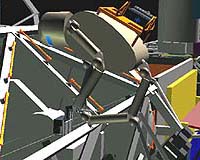| . |  |
. |
|
by Duncan Graham-Rowe for New Scientist  Houston - September 23, 1999 - It's arm twitched to life for the first time last week, and shortly afterwards reached out and screwed a nut onto a bolt. The first performance of NASA's Robonaut may not seem earth-shattering, but this robotic mechanic is headed for the big time--potentially making craft like the International Space Station a safer place.
Houston - September 23, 1999 - It's arm twitched to life for the first time last week, and shortly afterwards reached out and screwed a nut onto a bolt. The first performance of NASA's Robonaut may not seem earth-shattering, but this robotic mechanic is headed for the big time--potentially making craft like the International Space Station a safer place.Designed to be as human-like as possible, Robonaut will be controlled by telepresence--it will mimic the movements made by an astronaut who remains safely ensconced within a spacecraft. As the astronaut reaches out an arm, so does the robot. And if the human starts twisting a screwdriver, the robot should copy the action down to the slightest movement. The idea is to have a robot that responds to emergencies faster than the crew can. If something goes wrong, says Rob Ambrose, head of the robotic team at NASA's Johnson Space Center in Houston, it can take several hours for a member of the crew to get into a spacesuit and equipment, and pre-breathe low pressure air for a spacewalk. By that time it could be too late. Within the next few days, the Robonaut team plans to have the robot's head and neck and the other arm up and working, ready for a full upper-body test. Ambrose is confident that the group has already accomplished the most difficult part of the project: building the arm, which took them two and half years. "This is arguably the best robot arm ever built," Ambrose claims. It's not just the arm's strength and dexterity that make it special, according to Ambrose. With more than 150 sensors and built-in controllers it "knows" precisely how much pressure to apply when handling objects, just like a human arm and hand. And it is being customised for space. Special padding incorporating Kevlar and Teflon renders Robonaut both bulletproof--since space junk will be a big threat--and fireproof. Robonaut was built to do anything that a person can do, and more. "It can even scratch that part of your back that you just can't reach," says Ambrose. This, he explains, is because each joint has as many degrees of freedom as the human body, including four fingers and an opposable thumb on each hand, making it dextrous enough to tie a pair of shoelaces. Tri Nguyen, a technology assessor at NASA Johnson, says that autonomous versions of Robonauts could one day be used as maintenance droids for uncrewed missions. The robot can use any of the specialist tools that have been developed for astronauts. And the telepresence system makes operating it as easy as doing the repairs yourself. The operator can use either dual monitors or a virtual reality display to see what the robot's cameras see, while wearing a motion-sensitive body suit that provides control over where the droid goes. "The ultimate goal would be a totally visual system," says Enrico Di Bernardo, a vision expert at Caltech in Pasadena, who has assisted NASA with the telepresence interface. Using gesture recognition, operators would be able to immerse themselves completely in the scene without needing to wear a special suit, says Di Bernardo. This article will appear in the September 25 issue of New Scientist New Scientist. Copyright 1999 - All rights reserved. The material on this page is provided by New Scientist and may not be published, broadcast, rewritten or redistributed without written authorization from New Scientist.
|
| |||||||||
| The content herein, unless otherwise known to be public domain, are Copyright 1995-2016 - Space Media Network. All websites are published in Australia and are solely subject to Australian law and governed by Fair Use principals for news reporting and research purposes. AFP, UPI and IANS news wire stories are copyright Agence France-Presse, United Press International and Indo-Asia News Service. ESA news reports are copyright European Space Agency. All NASA sourced material is public domain. Additional copyrights may apply in whole or part to other bona fide parties. Advertising does not imply endorsement, agreement or approval of any opinions, statements or information provided by Space Media Network on any Web page published or hosted by Space Media Network. Privacy Statement All images and articles appearing on Space Media Network have been edited or digitally altered in some way. Any requests to remove copyright material will be acted upon in a timely and appropriate manner. Any attempt to extort money from Space Media Network will be ignored and reported to Australian Law Enforcement Agencies as a potential case of financial fraud involving the use of a telephonic carriage device or postal service. |